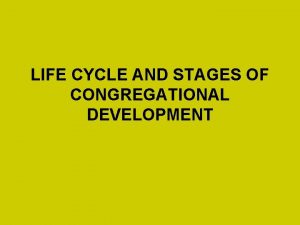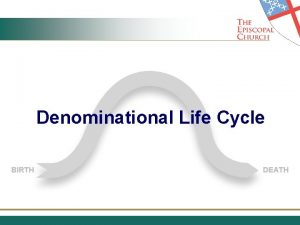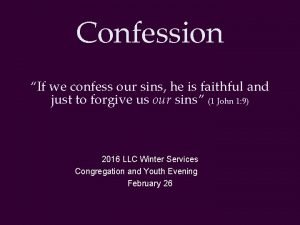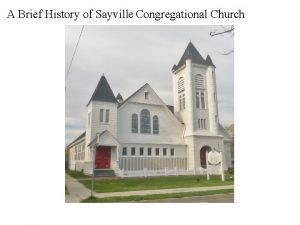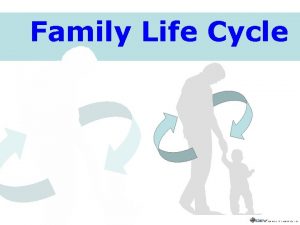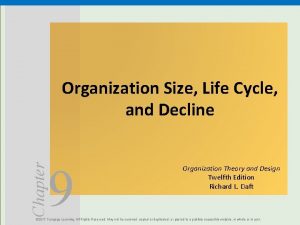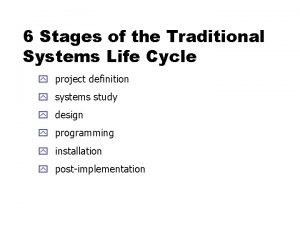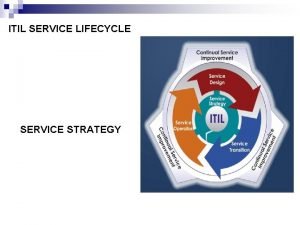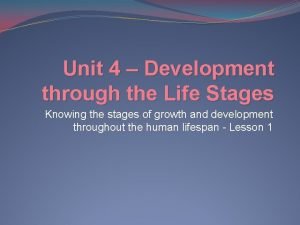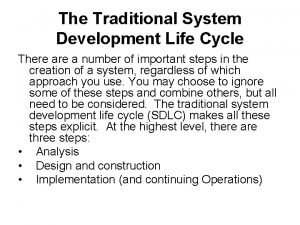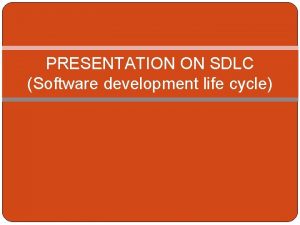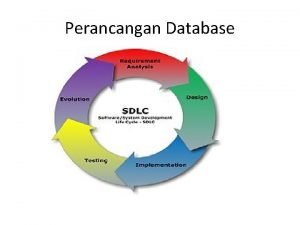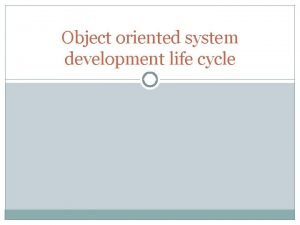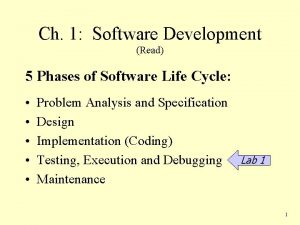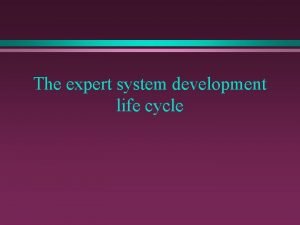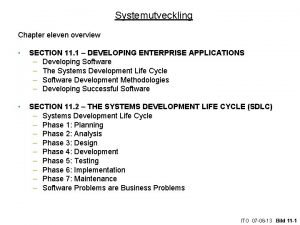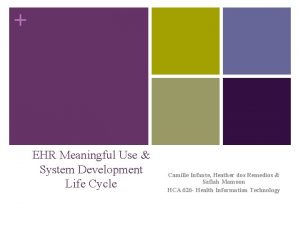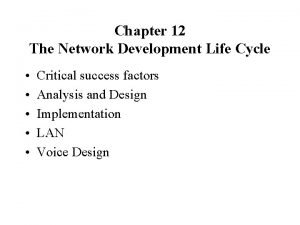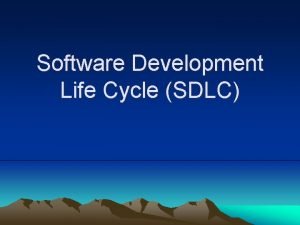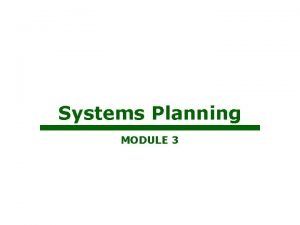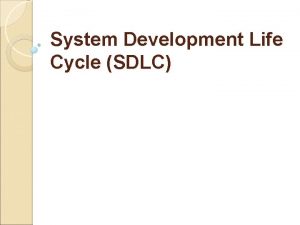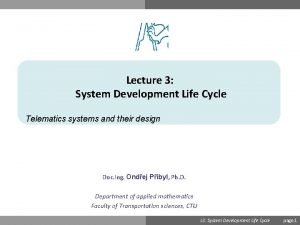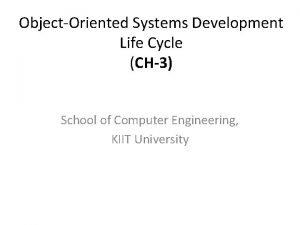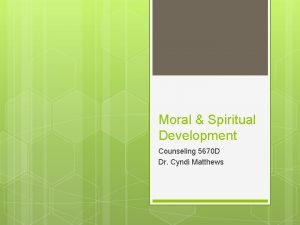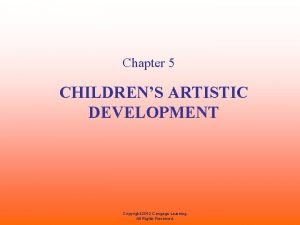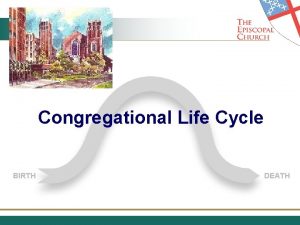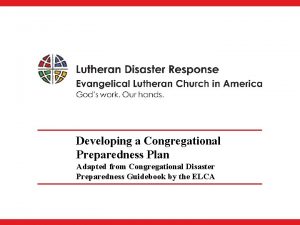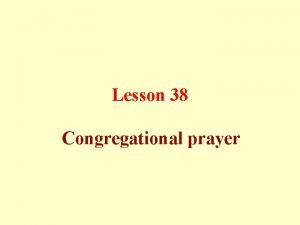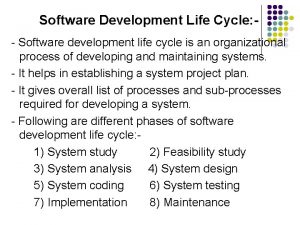The Life Cycle and Stages of Congregational Development






































































































- Slides: 102

The Life Cycle and Stages of Congregational Development

Five Phases The Life Cycle and Stages of Congregational Development has Five Phases. They are, Early Growth Late Growth Prime Early Aging Late Aging

Ten Stages of the Life Cycle l Birth l. Maturity l Infancy l. Empty Nest l Childhood l. Retirement l Adolescence l. Old Age l Adulthood l. Death

Gestation Before Birth and Infancy—Phase One—comes Gestation where a church planting effort is getting ready to launch into life through the Birth of a new congregation.

Gestation is a period of a couple of months to a couple of years before the Birth of a congregation when the idea of a new congregation is being developed through. . .

Gestation . . . prayer, planning, and preparation that emanates from a strong, positive, sense of spiritual passion.

Phase One: Early Growth Phase One is where a congregation develops deep roots and early growth around the issues of Vision and Relationships. They walk by faith rather than by sight.

Phase One: Early Growth This phase involves the following life cycle stages, Birth Infancy

Birth is that period when Vision is dominant, but relationships, programs, and management are not. Vision is the fuel or energy that drives a new congregation forward.

Birth Congregations at Birth are living out the mission, purpose, core values, and vision that God has given them for a new congregation that ought to be present in a certain place or target group of people.

Birth Leadership is expressed through Vision, and assists in fueling the forward progress of the congregation. This leadership is God’s leadership that empowers congregational leaders to seize the day.

Birth The period of Birth only lasts about six months to two years. It is characterized by a passion to fulfill the spiritual strategic vision of the congregation.

Birth During the Birth stage congregations must deal with various issues. First, is our Vision generational? Is it intended to provide leadership and focus for the first twenty or more years of the congregation?

Birth Second, what evangelism and congregational growth philosophy are we following? What methods do we need to use to bring the people to whom God has called us into a Christ-centric, faithbased journey and community?

Birth Third, how can we be missionary from the first day, while being the product of missions? How do we develop a servant mentality within the congregation while simultaneously being served by our sponsorship or parenthood?

Birth Fourth, what leadership and ministry styles are lay and pastoral leaders expressing? Will they be able to make the shift to different leadership styles as the congregation develops through the growing stages of the life cycle?

Birth Fifth, will the founding pastor have to leave to allow a pastor with a different set of gifts and skills to take us to the next stage?

Birth Will the congregation be stunted in its growth and development because the pastor does not adapt spiritual gifts and life skills, and does not move on in favor of a pastor who does have the necessary gifts and skills?

Birth Sixth, will the lay leadership make same or similar adjustments as the pastor, or will they also need to turnover?

Birth How will this leadership style crisis affect the congregation's ability to grow and develop in a healthy manner? How will it impact the congregation’s ability to successfully navigate the passage to the Infancy stage?

Infancy is that period when Vision and Relationships are dominant, but programs, and management are not. The period of Infancy lasts three to five years.

Infancy Congregations in Infancy are continuing to live out the Vision that God has given them for a congregation that ought to be present in a certain place or target group of people.

Infancy Vision is the fuel or energy that will drive the congregation forward throughout the growth side of the life cycle.

Infancy Discipleship patterns are expressed through the Relationships factor, and assist in flavoring the congregation. These patterns hard wire the congregation's qualitative and quantitative growth patterns.

Infancy During the Infancy stage congregations must deal with various issues. First, are our Relationships intentional? What evangelism and congregational growth philosophy are we following?

Infancy Do we know whom we, as a faith community, are gifted to reach for membership, and to make a focus of our outreach and missions efforts? Do we have regular, organized patterns of Relationships?

Infancy Second, do we have a clear understanding of our values and belief systems, or our spiritual identity?

Infancy Have we adequately grounded our members, regular attendees, and prospects in the doctrines and disciplines of our congregation, and—as appropriate—our denominational family?

Infancy The effort to clarify identity at times causes some people who have been a part of the congregation to seek another congregation because they do not agree with the emerging belief system, or the identity of the congregation as it was being clarified.

Infancy Third, do we actively work to assimilate people into the fellowship and care ministry life of the congregation? Do we go beyond being friendly to helping new people to develop lasting friendships within the congregational family?

Infancy Fourth, what is our style of worship? Do we use a traditional pattern, a contemporary pattern, or a blended style of worship? What is the place of preaching and teaching in worship? What is the place of music and liturgy?

Infancy Fifth, what are our tactics for lay mobilization? How do we involve people in ministry and missions activities? Do we help people become fully devoted followers of Christ?

Phase Two: Late Growth Phase Two is where a congregation develops and grows it Programs. They begin to walk by sight rather than by faith. This causes confusion by Adolescence.

Phase Two: Late Growth This phase involves the following life cycle stages, Childhood Adolescence

Childhood is that period when Vision and Programs are dominant, but relationships and management are not. The period of Childhood lasts five to six years.

Childhood The Childhood stage of a congregation is characterized by an urgency to build programs, ministries, and activities similar to a full service congregation.

Childhood Energy and resources that were dedicated to an intentional disciplemaking system during Infancy are now dedicated to program development.

Childhood During the Childhood stage significant emphasis is given to broadening the scale, and deepening the scope of the programs, ministries, and activities for the chosen high priority target groups.

Childhood In a family/household-oriented congregation, this can result in major emphasis on programs, ministries, and activities for children under eighteen years of age.

Childhood Several resource issues arise during Childhood. First, what programs, ministries, and activities do we have budget and special gifts dollars to support?

Childhood What can we fund through undesignated gifts, what will require designated gifts, and for what will we have to charge a fee?

Childhood Second, how should we focus our staff resources? Many congregations at this juncture have a pastor, secretary, and music director. Some will also have added a youth director.

Childhood Several of these may not be fulltime, if any are. Many may be volunteer. A key question will be what staff responsibilities to add next.

Childhood Third, facilities will be an issue. Few congregations can accurately predict exactly what type of facilities they will need for future programming.

Childhood Facilities may need to be renovated, programs groups moved around within the facilities, new facilities added, and new parking added.

Adolescence is that period when Vision, Relationships, and Programs are dominant, but management is not. The period of Adolescence lasts six to eight years.

Adolescence The Adolescence stage of a congregation is characterized by a passion to fulfill the strategic spiritual vision of the congregation. Because fulfillment of this Vision may be in sight, the congregation presses for a higher quality and quantity of ministry.

Adolescence Agendas addressed during Adolescence may include the following: 1. Staff and leadership. 2. Buildings and equipment. 3. Formalizing management systems.

Adolescence 4. Dealing with competing priorities expressed by laity. 5. Congregational emotions and awkwardness. 6. Raising the quality of programs.

Adolescence 7. Deepening personal spirituality and community relationships. 8. Consideration of jumping the curve to a second life cycle rather than continuing into Adulthood in this life cycle,

Adolescence 9. Doing significant and meaningful missions work and ministry projects. 10. Working harder on assimilating new people who connect with the congregation.

Adolescence Competition is evident in the congregation. Two visions of the future seem to be dominant in the congregation. People who affiliated with the congregation during Birth or Infancy hold one Vision.

Adolescence This is a Vision of a strong worshiping community with intimate fellowship and care, and meaningful, corporate spirituality.

Adolescence People who affiliated with the congregation during Childhood and Adolescence hold the other Vision. The programs, ministries, and activities of the congregation that met specific needs of the family or household attracted them.

Adolescence Their Vision is one of a full service, family-focused congregation with opportunities for meaningful, individual spirituality.

Phase Three: Prime Phase Three is where a congregation reaches its prime. In Adulthood they have a balance of walking by faith rather than by sight. This begins to weaken in Maturity.

Phase Three: Prime This phase involves the following life cycle stages, Adulthood Maturity

Adulthood is that period when Vision, Relationships, Programs, and Management are all four dominant. The period of Adulthood lasts three to five years.

Adulthood is characterized by a congregation that is in its prime. It is relaxed. It is successful. It has a positive spirit. It is focused. It is clear about its Vision, and its Vision shares broad ownership in the congregation.

Adulthood It is positive about its future. It feels that it can accomplish anything to which it sets it mind, as long as it matches the will of God for the congregation.

Adulthood A crucial characteristic is that the congregation may not be aware that this may be as good as it gets. It may not know that this is Adulthood.

Adulthood Having never been there, if this is the first life cycle of the congregation, they do not recognize Adulthood.

Adulthood Often the high morale of the congregation parallels the strong sense of mission, purpose, core values, and vision. The congregation feels that it is contributing significantly to the work of the Kingdom.

Adulthood High levels of satisfaction are expressed related to the role and function of the staff.

Maturity is that period when Relationships, Programs, and Management are dominant. Vision is no longer dominant. Management is controlling the direction of the congregation.

Maturity A congregation that is past its prime characterizes Maturity. It is more passive than active. It is still successful in many areas. For the most part it has a positive spirit.

Maturity The quality of what happens in Maturity is the highest of any stage in the life cycle. In fact, there is a crescendo of quality programs, ministries, and activities during this stage.

Maturity It is no longer focused. It is no longer clear about its vision. The success culture of the congregation keeps it moving forward. It is blind to the fact that it no longer has an empowering vision that is fueling it forward.

Maturity The feeling is that what the congregation is currently doing is working. There is no felt need to change. Besides, the finances of the congregation have never been better.

Maturity In selected portions of the congregation the morale of the members and regular attendees is beginning to decline. At the same time the congregation feels that it is contributing significantly to the work of the Kingdom.

Phase Four: Early Aging Phase Four is where a congregation diminishes first in programs, and then in relationships. They begin hard wire a pattern into their congregational life of walking by sight more than by faith.

Phase Four: Early Aging This phase involves the following life cycle stages, Empty Nest Retirement

Empty Nest is that period when Relationships and Management are dominant. Vision and programs are no longer dominant. Management is controlling the direction of the congregation.

Empty Nest has three phases: Nostalgia Disappointment Anger

Empty Nest The Nostalgia phase is when a congregation hopes that tomorrow will bring a return of yesterday. Most of the stories told in the congregation are stories of remembrance.

Empty Nest The Disappointment phase is when the congregation realizes that neither the quality nor the quantity of what the congregation is doing is what it once was.

Empty Nest The result is that in the Disappointment phase some congregational leaders push the commitment button, and urge people to be more committed to the work of the congregation.

Empty Nest The Anger phase is when a congregation seeks to focus blame on the things and persons who are keeping them from being what they once were, and what they desire to be.

Empty Nest The Anger phase can end up being a time of great conflict in the life of many congregations. The stress on pastoral leadership and lay leadership can be tremendous.

Empty Nest The congregation in Empty Nest may telegraph its time focus by the age group it wants to target with the most efforts. Congregations who want to target teenagers want to focus on yesterday.

Empty Nest Those who want to target senior adults want to focus on today. Congregations who want to target adults ages 25 to 45 and their children want to focus on tomorrow.

Retirement is that period when Programs and Management are dominant. Vision and relationships are no longer dominant. Management is controlling the direction of the congregation.

Retirement Many long-term members and attendees decided at the end of Empty Nest that this is no longer a good place to invite people to come and be members and attendees.

Retirement Existing members and attendees may feel that new people will be disappointed in the congregation. Or, new people may want to change the congregation, and if it does not work, then the congregation may be weaker than it is already.

Retirement Simultaneously they want the congregation to be alive and vital long enough to help them with various life passages, including their own death.

Retirement The stakeholders in the congregation who are 60 years of age or more, have been professing Christians for 40 years or more, and have been members for 20 years or more, give permission for the newer, younger members and attendees to try new programmatic directions.

Retirement At times this takes the form of an appeal made to a prospective pastor. The pastor search committee urges the new pastor to come lead them into a new era of transformation. Transitions, changes, and new ideas are said to be welcomed and supported.

Retirement About 18 to 24 months into the transitions and changes initiated by a pastor or newer, younger lay leaders, the stakeholders may realize that things are not working the way they thought they would.

Retirement If so, they seek to stop the change efforts, and—if necessary—get rid of or discourage the leaders of the transitions and changes.

Phase Five: Late Aging Phase Five is where a congregation institutionalizes its Management, and loses sight of vision and relationships. They walk by sight only.

Phase Five: Late Aging This phase involves the following life cycle stages, Old Age Death

Old Age is that period when Management is the only one of the four organizing principles which is dominant. Vision, relationships, and programs are no longer dominant. Management is the only thing left to control the direction of the congregation.

Old Age is that stage of a congregation’s life cycle when it is functioning on fumes rather than being fueled by Vision. The habit or pattern of gathering for worship and fellowship is the primary factor keeping the congregation going.

Old Age The congregation is now at subsistence level. It is a preaching station, or a chaplaincy ministry. Death is not necessarily nearby, but proactive meaningful congregation life that is generating new energy is gone.

Old Age Death is not necessarily imminent or inevitable for Old Age congregations. It is not imminent in that Old Age congregations generally have the ability and resources to survive long past any viable, proactive ministry life.

Death is that period when none of the four organizing principles is dominant. Vision, relationships, and programs are no longer even present. Management is the only organizing principle left, and its role is brief and confined.

Death At Death a congregation ceases to exist as a community of worship, discipleship, and fellowship. The desire is gone to meet regularly to worship God, to engage in spiritual growth activities, and to actively organize for fellowship and mutual support.

Death Probably all three of these need to exist in some regular form for congregational life to be viable. What dies when these three are not present is the congregational movement.

Death During the latter stages of congregational life many members and regular attendees probably deepened their inability to divide their faith in Christ from the cultural practices of a specific congregation in a specific location.

Death is not inevitable for any congregation. The life cycle and stages of development are not deterministic; that is, if a congregation has a Birth, it is not inevitable that it will have a Death.

Death Having said that Death is not inevitable, congregations who are aging, are dysfunctional, and who wait until Late Aging to seek a turnaround are unlikely to experience a positive, successful future. They may not avoid Death.

 Congregational life cycle
Congregational life cycle Congregational life cycle
Congregational life cycle Sdlc analysis phase
Sdlc analysis phase Database development life cycle in dbms
Database development life cycle in dbms Congregational confession this is my bible
Congregational confession this is my bible Cornerstone congregational church
Cornerstone congregational church Sayville congregational church
Sayville congregational church Replacement chart in hrm
Replacement chart in hrm Wolverine
Wolverine Insect life cycle
Insect life cycle What is a snow leopards life cycle
What is a snow leopards life cycle What are the 5 stages of product life cycle
What are the 5 stages of product life cycle Do cockroaches live in cocks
Do cockroaches live in cocks A life cycle of a tiger
A life cycle of a tiger Star life cycle
Star life cycle Star life cycle simulation
Star life cycle simulation 5 stages of family life cycle
5 stages of family life cycle African elephant life cycle
African elephant life cycle Organizational life cycle stages
Organizational life cycle stages Chegg
Chegg Mammal life cycle stages
Mammal life cycle stages Life history of schistosoma
Life history of schistosoma Financial life cycle stages
Financial life cycle stages Kangaroo anatomy female
Kangaroo anatomy female Traditional system development life cycle
Traditional system development life cycle Vivax plasmodium
Vivax plasmodium Itil service management lifecycle
Itil service management lifecycle Life cycle of expert system
Life cycle of expert system Turtle life cycle stages
Turtle life cycle stages Family life cycle stages
Family life cycle stages Reproductive termites
Reproductive termites Definition of maturation
Definition of maturation New product development and product life cycle strategies
New product development and product life cycle strategies Traditional system development
Traditional system development Systems development life cycle
Systems development life cycle Sdlc conclusion
Sdlc conclusion Contoh database system development life cycle
Contoh database system development life cycle Lec hardver
Lec hardver Object oriented system development life cycle in ooad
Object oriented system development life cycle in ooad Multimedia software development
Multimedia software development Modelling of edlc in embedded system
Modelling of edlc in embedded system Odw 5e ch05 arrange the software development life cycle
Odw 5e ch05 arrange the software development life cycle Expert system life cycle
Expert system life cycle Document development life cycle
Document development life cycle System development life cycle of electronic health records
System development life cycle of electronic health records Document development life cycle technical writing
Document development life cycle technical writing Odw 5e ch05 arrange the software development life cycle
Odw 5e ch05 arrange the software development life cycle Network development life cycle
Network development life cycle Cmmi software development life cycle
Cmmi software development life cycle Object oriented development life cycle
Object oriented development life cycle System development life cycle
System development life cycle System development life cycle
System development life cycle Sysyem software
Sysyem software Product development life cycle methodology
Product development life cycle methodology Cross life cycle activity of system development is
Cross life cycle activity of system development is Kendall system analysis and design
Kendall system analysis and design Traditional systems development life cycle
Traditional systems development life cycle Hp agile manager alm
Hp agile manager alm Object oriented development life cycle
Object oriented development life cycle Social changes in adulthood
Social changes in adulthood Rudimentary movement phase
Rudimentary movement phase Stages of human growth and development pictures
Stages of human growth and development pictures Late childhood
Late childhood Pattern of growth and development
Pattern of growth and development 6 life stages
6 life stages Undifferentiated stage of spiritual development
Undifferentiated stage of spiritual development Enumerate the rice plant growth and development stages
Enumerate the rice plant growth and development stages Theories of child art development
Theories of child art development Hình ảnh bộ gõ cơ thể búng tay
Hình ảnh bộ gõ cơ thể búng tay Slidetodoc
Slidetodoc Bổ thể
Bổ thể Tỉ lệ cơ thể trẻ em
Tỉ lệ cơ thể trẻ em Gấu đi như thế nào
Gấu đi như thế nào Thang điểm glasgow
Thang điểm glasgow Alleluia hat len nguoi oi
Alleluia hat len nguoi oi Môn thể thao bắt đầu bằng chữ đua
Môn thể thao bắt đầu bằng chữ đua Thế nào là hệ số cao nhất
Thế nào là hệ số cao nhất Các châu lục và đại dương trên thế giới
Các châu lục và đại dương trên thế giới Công thức tiính động năng
Công thức tiính động năng Trời xanh đây là của chúng ta thể thơ
Trời xanh đây là của chúng ta thể thơ Cách giải mật thư tọa độ
Cách giải mật thư tọa độ Phép trừ bù
Phép trừ bù độ dài liên kết
độ dài liên kết Các châu lục và đại dương trên thế giới
Các châu lục và đại dương trên thế giới Thơ thất ngôn tứ tuyệt đường luật
Thơ thất ngôn tứ tuyệt đường luật Quá trình desamine hóa có thể tạo ra
Quá trình desamine hóa có thể tạo ra Một số thể thơ truyền thống
Một số thể thơ truyền thống Cái miệng bé xinh thế chỉ nói điều hay thôi
Cái miệng bé xinh thế chỉ nói điều hay thôi Vẽ hình chiếu vuông góc của vật thể sau
Vẽ hình chiếu vuông góc của vật thể sau Nguyên nhân của sự mỏi cơ sinh 8
Nguyên nhân của sự mỏi cơ sinh 8 đặc điểm cơ thể của người tối cổ
đặc điểm cơ thể của người tối cổ Thế nào là giọng cùng tên? *
Thế nào là giọng cùng tên? * Vẽ hình chiếu đứng bằng cạnh của vật thể
Vẽ hình chiếu đứng bằng cạnh của vật thể Phối cảnh
Phối cảnh Thẻ vin
Thẻ vin đại từ thay thế
đại từ thay thế điện thế nghỉ
điện thế nghỉ Tư thế ngồi viết
Tư thế ngồi viết Diễn thế sinh thái là
Diễn thế sinh thái là Dạng đột biến một nhiễm là
Dạng đột biến một nhiễm là So nguyen to
So nguyen to Tư thế ngồi viết
Tư thế ngồi viết Lời thề hippocrates
Lời thề hippocrates
